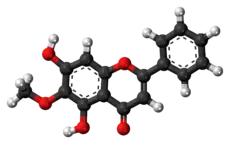 | |
 | |
| Names | |
|---|---|
| IUPAC name
5,7-Dihydroxy-6-methoxyflavone | |
| Systematic IUPAC name
5,7-Dihydroxy-6-methoxy-2-phenyl-4H-1-benzopyran-4-one | |
| Other names
Baicalein 6-methyl ether | |
| Identifiers | |
3D model (JSmol) |
|
| ChEBI | |
| ChemSpider | |
| ECHA InfoCard | 100.189.623 |
| KEGG | |
PubChem CID |
|
| UNII | |
CompTox Dashboard (EPA) |
|
| |
| |
| Properties | |
| C16H12O5 | |
| Molar mass | 284.26 g/mol |
Except where otherwise noted, data are given for materials in their standard state (at 25 °C [77 °F], 100 kPa).
Infobox references | |
Oroxylin A is an O-methylated flavone, a chemical compound that can be found in the medicinal plants Scutellaria baicalensis[1] and Scutellaria lateriflora,[2][3] and the Oroxylum indicum tree.[4] It has demonstrated activity as a dopamine reuptake inhibitor,[5] and is also a negative allosteric modulator of the benzodiazepine site of the GABAA receptor.[5][6][7] Oroxylin A has been found to improve memory consolidation in mice by elevating brain-derived neurotrophic factor (BDNF) levels in the hippocampus.[8]
See also
References
- ↑ Isolation and purification of baicalein, wogonin and oroxylin A from the medicinal plant Scutellaria baicalensis by high-speed counter-current chromatography. Hua-Bin Li and Feng Chen, Journal of Chromatography A, 13 May 2005, Volume 1074, Issues 1–2, pages 107–110, doi:10.1016/j.chroma.2005.03.088
- ↑ Li J, Ding Y, Li XC, Ferreira D, Khan S, Smillie T, Khan IA (2009). "Scuteflorins A and B, dihydropyranocoumarins from Scutellaria lateriflora". J. Nat. Prod. 72 (6): 983–7. doi:10.1021/np900068t. PMID 19555121.
- ↑ Nishikawa K, et al. (1999). "Phenolics in tissue cultures of Scutellaria" (PDF). Natural Medicines. 53 (4): 209–13.
- ↑ The constitution of oroxylin-A, a yellow colouring matter from the root-bark of Oroxylum indicum, vent R. C. Shah, C. R. Mehta and T. S. Wheeler
- 1 2 Yoon, Seo Young; dela Peña, Ike; Kim, Sung Mok; Woo, Tae Sun; Shin, Chan Young; Son, Kun Ho; Park, Haeil; Lee, Yong Soo; Ryu, Jong Hoon; Jin, Mingli; Kim, Kyeong-Man; Cheong, Jae Hoon (2013). "Oroxylin A improves attention deficit hyperactivity disorder-like behaviors in the spontaneously hypertensive rat and inhibits reuptake of dopamine in vitro". Archives of Pharmacal Research. 36 (1): 134–140. doi:10.1007/s12272-013-0009-6. ISSN 0253-6269. PMID 23371806. S2CID 23927252.
- ↑ Liao JF, Wang HH, Chen MC, Chen CC, Chen CF (1998). "Benzodiazepine binding site-interactive flavones from Scutellaria baicalensis root". Planta Med. 64 (6): 571–2. doi:10.1055/s-2006-957517. PMID 9776664.
- ↑ Liu X, Hong SI, Park SJ, Dela Peña JB, Che H, Yoon SY, Kim DH, Kim JM, Cai M, Risbrough V, Geyer MA, Shin CY, Cheong JH, Park H, Lew JH, Ryu JH (2013). "The ameliorating effects of 5,7-dihydroxy-6-methoxy-2(4-phenoxyphenyl)-4H-chromene-4-one, an oroxylin A derivative, against memory impairment and sensorimotor gating deficit in mice". Arch. Pharm. Res. 36 (7): 854–63. doi:10.1007/s12272-013-0106-6. PMID 23543630. S2CID 2554248.
- ↑ Kim DH, Lee Y, Lee HE, Park SJ, Jeon SJ, Jeon SJ, Cheong JH, Shin CY, Son KH, Ryu JH (2014). "Oroxylin A enhances memory consolidation through the brain-derived neurotrophic factor in mice". Brain Res. Bull. 108: 67–73. doi:10.1016/j.brainresbull.2014.09.001. PMID 25218897. S2CID 21456826.
This article is issued from Wikipedia. The text is licensed under Creative Commons - Attribution - Sharealike. Additional terms may apply for the media files.